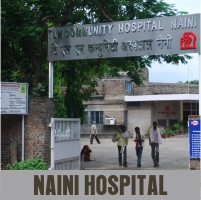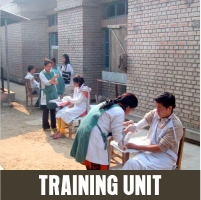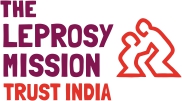
Welcome to the Leprosy Mission’s Naini Hospital
TLM Naini Hospital is a community hospital located in Naini, Allahabad (Uttar Pradesh, India). TLM Naini is one of the 14 hospitals of The Leprosy Mission Trust India across India. We have a strong emphasis on ethical medical practice that always puts the patient’s interest first.
The hospital prominently focuses on leprosy and aims to alleviate the suffering of leprosy-affected people by treating the disease and its complications. Multi-Drug Therapy (MDT), treatment of leprosy reactions, deformity, Re-Constructive Surgery (RCS), MCR and Special Footwear, Splints, POD activities, social development & capacity building. Integrated general services are also available such as Obstetrics and Gynaecology, Medicine, Surgery, Dermatology, Physio & Occupational therapy, Laboratory etc.


DEPARTMENTS

The primary objective of Leprosy Mission Naini Hospital is to alleviate the suffering of individuals affected by leprosy by providing comprehensive treatment for the disease and its associated complications. The hospital offers various services and interventions, including Multi-Drug Therapy (MDT) for leprosy treatment, management of leprosy reactions, addressing deformities, reconstructive surgery, provision of special footwear (MCR) and splints, activities related to prevention of disability (PiOD), social development initiatives, and capacity building programs.
Additionally, the hospital provides integrated general services, encompassing obstetrics and gynaecology, internal medicine, surgery, dermatology, physiotherapy, occupational therapy, and laboratory services. This comprehensive approach ensures that individuals affected by leprosy receive holistic care and support to improve their quality of life.
.

Since 1980, the Training Unit at Leprosy Mission Naini has been actively enhancing the skills and knowledge of medical and paramedical professionals from government and non-governmental organizations (NGOs). The training program’s effectiveness stems from several key factors. Firstly, the high leprosy case load at the facility offers a diverse clinical spectrum of leprosy and its associated complications, providing valuable hands-on experience. Additionally, the training benefits from dedicated and experienced faculty passionate about their work. The infrastructure at the facility is well-equipped with audio-visual aids, spacious classrooms, comfortable lodging, boarding facilities, and recreational amenities to ensure a conducive learning environment.

Mercy Home, located within the Leper Mission in Naini and founded in 1876, serves as a refuge for individuals affected by leprosy who have been abandoned by their families. Presently, only those who face social ostracism are granted admission, following comprehensive evaluations conducted by dedicated social and medical personnel. The residents of Snehalya are considered integral members of the TLM Naini community, residing within the campus. They receive essential provisions such as food and clothing, engage in recreational activities and interactions, and benefit from a specialized geriatric nursing facility, ensuring their well-being and independence.
FREQUENTLY ASKED QUESTION (F.A.Q.)
What is Leprosy ?
Leprosy is a chronic infectious disease caused by a bacillus, Mycobacterium leprae. M leprae multiplies slowly and the incubation period of the disease, on average, is five years. Symptoms may occur within one year but can take as long as 20 years or more.
Why is leprosy also called Hansen's disease?
Leprosy is caused by a slow-growing type of bacteria called Mycobacterium leprae (M. leprae). Leprosy is also known as Hansen’s disease after the scientist discovered M. leprae
How many people suffer from leprosy today?
More than 16 million leprosy patients have been treated with MDT over the past 20 years. Though gradual, a general reduction in new cases is observed in several countries. The new cases were reduced to 202 256 in 2019. Several countries reported less number cases, including 45 countries that reported zero leprosy cases.
Where does leprosy occur nowadays?
Leprosy is endemic in several states and union territories of India, with an annual case detection rate of 4.56 per 10 000 population. The prevalence rate of leprosy is 0.4 per 10,000 population in the country. Of the new cases detected during 2020-2021, 58.1% were multibacillary, 39% were women, 5.8% were children less than 14 years of age, and 2.41% had visible deformities. The rate of visible deformities was 1.1 per million population.
